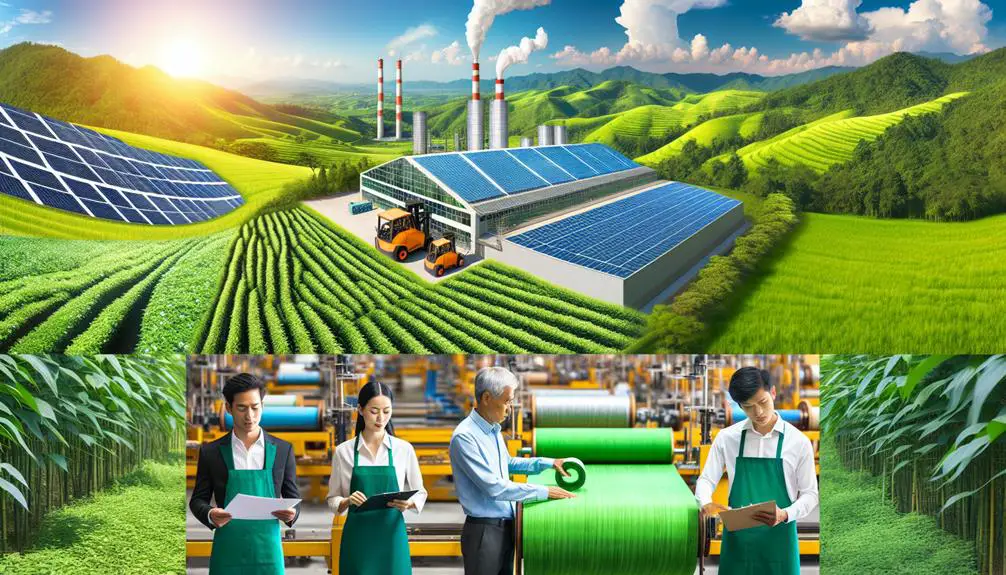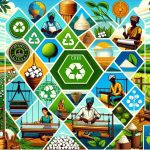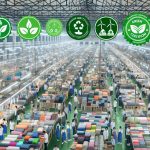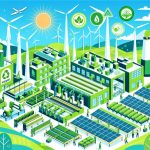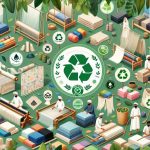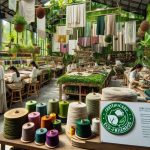You might not know that the Global Organic Textile Standard (GOTS) not only covers the ecological criteria for textiles but also guarantees social responsibility at every stage of production. Certifications like GOTS, OEKO-TEX Standard 100, and Fair Trade Certified play vital roles in promoting sustainable fabric production. They provide a framework that guarantees eco-friendly materials and fair labor practices, but how do these certifications differ, and what specific benefits do they offer to both consumers and manufacturers? Understanding these distinctions can greatly impact your choices in sustainable fashion.
Table of Contents
Key Takeaways
- The Global Organic Textile Standard (GOTS) certifies the organic status and sustainable practices in textile production.
- OEKO-TEX Standard 100 ensures textiles are free from harmful substances and exceed global safety standards.
- Fair Trade Certified guarantees fair wages, safe working conditions, and strict social, economic, and environmental standards.
- The Bluesign® System enforces sustainable fabric production through stringent chemical management and eco-friendly dyeing techniques.
- Cradle to Cradle Certified evaluates sustainability across material health, recyclability, renewable energy, water stewardship, and social fairness.
Global Organic Textile Standard
The Global Organic Textile Standard (GOTS) sets the benchmark for certifying the organic status of textiles from harvesting to labeling. If you're committed to sustainability practices in textile production, understanding GOTS is essential. This certification guarantees that every step of your textile process meets rigorous environmental criteria, emphasizing the importance of organic cotton sourcing.
When you source organic cotton, you're not just choosing a superior raw material; you're committing to a sustainable and ethical supply chain. GOTS mandates that the cotton used is grown without synthetic pesticides or GMOs, promoting a healthier ecosystem and safer working conditions for farmers. This focus on organic cotton sourcing aligns perfectly with sustainable practices by reducing environmental impact and ensuring product safety.
Additionally, GOTS certification extends beyond raw materials. It requires that processing units adhere to strict environmental and social criteria, like wastewater treatment and fair labor practices. By integrating GOTS standards into your production, you're not only enhancing your brand's credibility but also contributing to a more sustainable future.
Mastering these standards will set your textiles apart, reflecting a commitment to quality and responsibility that today's discerning consumers demand.
OEKO-TEX Standard 100
OEKO-TEX Standard 100 certifies that every component of a textile product, from threads to buttons, is free from harmful substances. This certification guarantees compliance with stringent textile safety regulations, providing you with the confidence that your materials are both safe and sustainable.
To earn this certification, products undergo rigorous testing for over 100 harmful substances, including pesticides, heavy metals, and formaldehyde. The tests are conducted by independent OEKO-TEX partner institutes, ensuring unbiased results. By adhering to OEKO-TEX Standard 100, you're not only meeting but exceeding global safety standards, an essential step in sustainable manufacturing.
You might wonder why this certification is so vital. Well, it protects consumers from potential health risks associated with toxic chemicals. It also demonstrates your commitment to responsible production practices, which is increasingly important in today's eco-conscious market. Sustainable manufacturing isn't just a trend; it's a necessity for the future.
Moreover, OEKO-TEX Standard 100 certification can provide a competitive edge. It reassures customers that your products are designed with their health and the environment in mind. By choosing certified materials, you're fostering a safer, more sustainable textile industry, setting yourself apart as a leader in responsible manufacturing.
Fair Trade Certified
Selecting Fair Trade Certified materials guarantees that the individuals behind your products receive fair wages and work under safe conditions. This certification stands as a proof of your commitment to ethical sourcing and an equitable supply chain. By choosing Fair Trade Certified fabrics, you make sure that every step of production, from farming to final assembly, adheres to strict social, economic, and environmental standards.
You're not just purchasing a product; you're investing in the well-being of communities and the planet. Fair Trade principles include fair prices, no child labor, safe working environments, and community development. These standards create a ripple effect, promoting sustainable livelihoods and uplifting entire communities.
Moreover, transparency is key in the Fair Trade supply chain. You can trace the journey of your fabric, knowing exactly where and how it was produced. This level of traceability not only bolsters consumer trust but also aligns with your goal of mastering ethical sourcing.
Incorporating Fair Trade Certified materials into your products showcases your dedication to responsible business practices. It's a powerful way to differentiate your brand and connect with conscious consumers who value ethical production.
Bluesign® System
The Bluesign® System guarantees sustainable fabric production by enforcing strict chemical management standards.
You'll see how it pushes for resource efficiency innovations, reducing environmental impact.
This certification helps you make informed choices about eco-friendly textiles.
Chemical Management Standards
Bluesign® System sets stringent standards for chemical management in sustainable fabric production, ensuring safety and environmental responsibility. By adhering to Bluesign®'s protocols, you'll implement waste reduction strategies and sustainable sourcing practices that minimize environmental impact.
The system mandates that all raw materials and chemicals are vetted for harmful effects before use, enabling you to make informed decisions that prioritize both human health and ecological balance.
You'll also benefit from eco-friendly dyeing techniques, which notably lower water and energy consumption. Bluesign® promotes the use of dyes and finishes that are free from hazardous substances, ensuring that your processes are as clean as possible.
Pollution prevention measures are integral to the system, helping you to mitigate the release of toxic chemicals into waterways and the atmosphere. This not only protects the environment but also enhances the safety of your workforce.
Resource Efficiency Innovations
You'll discover groundbreaking resource efficiency innovations that notably reduce waste and conserve natural resources. The Bluesign® System is a pioneer in this field, implementing circular economy practices and waste reduction strategies to achieve sustainable fabric production. By focusing on optimizing resource use, Bluesign® minimizes the environmental impact at every stage of the textile supply chain.
One of the core principles of Bluesign® is maximizing resource efficiency. They employ advanced technologies to ensure minimal water and energy use, reducing the carbon footprint of textile production significantly. Additionally, Bluesign® promotes the reuse and recycling of materials, embracing circular economy practices that keep resources in use for as long as possible.
To give you a clearer picture, here's a comparison of traditional practices versus Bluesign® innovations:
| Aspect | Traditional Practices | Bluesign® Innovations |
|---|---|---|
| Water Usage | High | Noticeably Reduced |
| Energy Consumption | Inefficient | Optimized |
| Material Waste | High | Minimized through Recycling |
Cradle to Cradle Certified
When you're looking at Cradle to Cradle Certified, you'll find a thorough certification process that evaluates a product's sustainability from start to finish.
This includes evaluating the environmental impact across five key categories, ensuring materials are safe, recyclable, and responsibly sourced.
Certification Process Overview
The Cradle to Cradle Certified certification process evaluates fabric production from material health to social fairness, providing a thorough assessment of sustainability. By focusing on core areas like material reutilization, renewable energy, and water stewardship, the certification delivers significant industry impact and environmental benefits. You'll find that this process is designed to push for continuous improvement in sustainable fabric production.
To achieve this certification, you need to meet stringent compliance requirements across five categories: Material Health, Material Reutilization, Renewable Energy and Carbon Management, Water Stewardship, and Social Fairness. Each category has its own set of criteria that you must satisfy, ensuring a detailed evaluation of your production methods.
Here's a quick overview of the certification process:
| Category | Key Compliance Requirements |
|---|---|
| Material Health | Eliminate harmful substances, guarantee safe inputs. |
| Material Reutilization | Design for a circular economy, facilitate recycling. |
| Renewable Energy and Carbon Management | Utilize renewable energy, decrease carbon footprint. |
| Water Stewardship | Implement water-saving measures, guarantee clean water. |
| Social Fairness | Safeguard human rights, advocate for fair labor practices. |
Environmental Impact Assessment
Evaluating the environmental impact of fabric production through the Cradle to Cradle Certified framework guarantees that your practices contribute positively to the planet. This certification isn't just a label; it's a commitment to a thorough and sustainable approach.
You'll need to conduct a life cycle survey (LCS) to understand the full environmental footprint of your fabric—from raw material extraction to end-of-life disposal. By evaluating every stage, you can pinpoint areas for improvement and make sure that your products are as eco-friendly as possible.
Another critical component is carbon footprint analysis. By measuring and reducing your carbon emissions, you take concrete steps to combat climate change. The Cradle to Cradle Certified framework emphasizes the importance of renewable energy and carbon management, ensuring that your operations are aligned with global sustainability goals.
To make the process more digestible, here are three key steps you should follow:
- Perform a Life Cycle Survey (LCS): Evaluate the environmental impacts at each stage of your fabric's life.
- Conduct Carbon Footprint Analysis: Measure and reduce greenhouse gas emissions associated with your production.
- Implement Sustainable Practices: Use renewable energy and sustainable materials to minimize negative impacts.
Recycled Claim Standard
Adhering to the Recycled Claim Standard guarantees that a product's recycled materials are verified and tracked throughout the entire supply chain. When you implement this standard, the verification process confirms that every material used is accurately certified. This rigorous process introduces transparency requirements, offering you a clear view of the origins and handling of your recycled materials.
By committing to these standards, you're actively supporting the circular economy. This means you're not just reducing waste but also promoting sustainable production practices. Supply chain audits play a critical role here, making sure that each stage—from collection to processing—is thoroughly examined and compliant.
Here's a snapshot of what you can expect:
| Step | Description |
|---|---|
| Material Collection | Gathering post-consumer or post-industrial waste |
| Processing | Converting waste into reusable raw materials |
| Certification | Verifying the authenticity of recycled content |
| Manufacturing | Integrating certified materials into new products |
| Final Product | Confirming the end product meets the Recycled Claim Standard |
Embracing the Recycled Claim Standard not only enhances your brand's reputation but also contributes to a more sustainable future. Your commitment to these standards showcases your dedication to quality and environmental responsibility.
Forest Stewardship Council
Often regarded as a gold standard in responsible forest management, the Forest Stewardship Council (FSC) certification guarantees that products come from responsibly managed forests that provide environmental, social, and economic benefits. If you're aiming to master sustainable fabric production, understanding FSC certification is essential.
The FSC ensures that forests are managed in a way that preserves biodiversity and benefits the lives of local people and workers, while sustaining economic viability. Their rigorous standards are globally recognized, making FSC-certified products a trusted choice for eco friendly practices.
Here's how FSC certification can enhance your sustainable fabric production:
- Sustainable Sourcing: FSC-certified materials ensure that your fabrics come from forests that are managed sustainably, promoting long-term ecological balance.
- Market Credibility: Using FSC-certified products demonstrates your commitment to responsible forest management, enhancing your brand's reputation for sustainability.
- Consumer Trust: With increasing consumer awareness, FSC certification assures your customers that your products contribute positively to environmental and social sustainability.
Frequently Asked Questions
What Are the Career Benefits of Obtaining a Certification in Sustainable Fabric Production?
Obtaining this certification boosts your career advancement by increasing industry credibility. You'll access higher salary potential and diverse job opportunities, making you a sought-after expert in sustainable practices. Your mastery propels you ahead in the competitive market.
How Do Certifications Impact the Cost of Sustainable Fabrics?
Certifications impact the cost of sustainable fabrics by increasing production standards, boosting market demand, and enhancing quality. You'll find that higher standards and increased demand often lead to a rise in production costs, but also in product value.
Are There Certifications Specifically for Small-Scale Fabric Producers?
Yes, there are certifications tailored for small-scale fabric producers. These programs often include specialized training programs and adhere to global standards, ensuring you can compete effectively while maintaining sustainability and ethical practices.
How Can Consumers Verify the Authenticity of Sustainable Fabric Certifications?
You can verify the authenticity of sustainable fabric certifications by researching the verification process. Building consumer trust involves understanding greenwashing detection and ensuring ethical sourcing practices. Look for transparency and third-party audits to avoid being misled.
What Role Do Certifications Play in Reducing Carbon Footprints in Textile Production?
Imagine a river flowing clear after a storm. Certifications act like filters, ensuring textile production processes focus on carbon offsetting. They streamline supply chains, reducing the environmental impact and guiding you toward more sustainable choices.
- Tetron Fabric for Marine Applications: Durability and Use Cases - June 18, 2025
- Tetron Fabric for Outdoor Furniture: Weather Resistance and Care - June 18, 2025
- Tetron Fabric for Wall Coverings: Style and Application Tips - June 18, 2025

